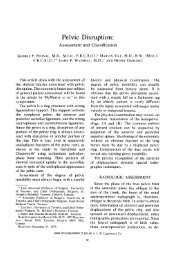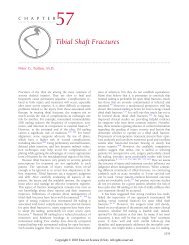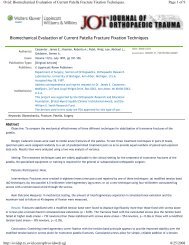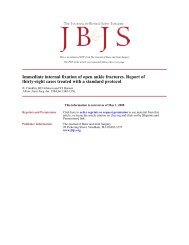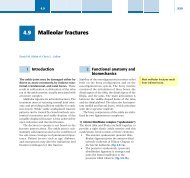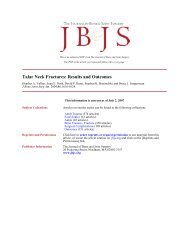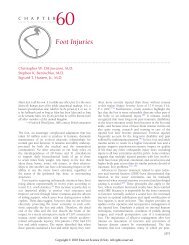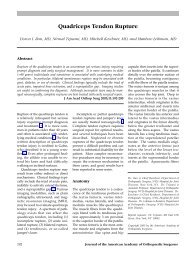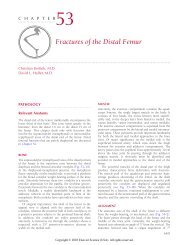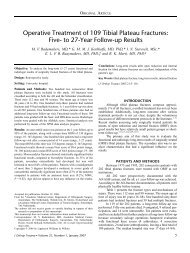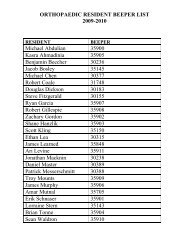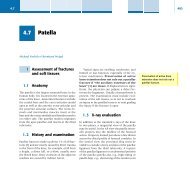Fixation with a Cannulated Screw Displaced Scaphoid Fractures ...
Fixation with a Cannulated Screw Displaced Scaphoid Fractures ...
Fixation with a Cannulated Screw Displaced Scaphoid Fractures ...
You also want an ePaper? Increase the reach of your titles
YUMPU automatically turns print PDFs into web optimized ePapers that Google loves.
This is an enhanced PDF from The Journal of Bone and Joint SurgeryThe PDF of the article you requested follows this cover page.<strong>Displaced</strong> <strong>Scaphoid</strong> <strong>Fractures</strong> Treated <strong>with</strong> Open Reductio and Internal<strong>Fixation</strong> <strong>with</strong> a <strong>Cannulated</strong> <strong>Screw</strong>Thomas E. Trumble, Mary Gilbert, Lorne W. Murray, Jeffery Smith and Wren V. McCallisterJ Bone Joint Surg Am. 2000;82:633.This information is current as of August 27, 2008Reprints and PermissionsPublisher InformationClick here to order reprints or request permission to use material from thisarticle, or locate the article citation on jbjs.org and click on the [Reprints andPermissions] link.The Journal of Bone and Joint Surgery20 Pickering Street, Needham, MA 02492-3157www.jbjs.org
<strong>Displaced</strong> <strong>Scaphoid</strong> <strong>Fractures</strong> Treated <strong>with</strong> Open Reductionand Internal <strong>Fixation</strong> <strong>with</strong> a <strong>Cannulated</strong> <strong>Screw</strong> *BY THOMAS E. TRUMBLE, M.D.†, MARY GILBERT, M.A.†, LORNE W. MURRAY, B.S.†,JEFFERY SMITH, M.D.†, GREG RAFIJAH, M.D.†, AND WREN V. MCCALLISTER, M.D.†Investigation performed at the University of Washington Medical Center, Seattle, WashingtonAbstractBackground: This study was performed to determineif the accuracy of screw placement was improved<strong>with</strong> use of the Herbert-Whipple cannulated screwcompared <strong>with</strong> use of the AO/ASIF cannulated screwand also to evaluate the functional results in patients<strong>with</strong> an acute displaced fracture of the waist of thescaphoid treated <strong>with</strong> open reduction and internal fixation<strong>with</strong> a cannulated screw.Methods: We retrospectively reviewed the resultsfor thirty-five patients in whom an acute displaced fractureof the waist of the scaphoid had been treated <strong>with</strong>internal fixation <strong>with</strong> use of a cannulated screw. The patientswere divided into two groups; Group 1 consistedof nineteen patients managed <strong>with</strong> a 3.5-millimeter cannulatedAO/ASIF screw from 1990 through 1997, andGroup 2 consisted of sixteen patients managed <strong>with</strong> aHerbert-Whipple screw from 1993 through 1997.Results: There were no clinical or radiographic differencesbetween the two groups. The average time tounion (and standard deviation), confirmed <strong>with</strong> tomography,was 4.2 ± 1.2 months for Group 1 and 4.0 ± 1.2months for Group 2. Both screws significantly improvedthe alignment of the scaphoid and decreasedcarpal collapse (p < 0.01). Importantly, the use of eithercannulated screw improved the height-to-length ratioand the lateral intrascaphoid angle, which were correlated<strong>with</strong> an increase in the range of motion of thewrist (r = 0.584 and 0.625). In addition, both screws allowedfor accurate placement in the central portion ofthe proximal pole. Regardless of the type of screw used,the time to union increased <strong>with</strong> increasing age of thepatient (r = 0.665) and <strong>with</strong> increasing initial displacementof the fracture (r = 0.541). Within both groups, thetime to union was longer for the patients who smoked(p < 0.01).Conclusions: Within both groups, cannulated screwfixation maintained the corrected fracture alignmentand promoted healing and return of function. Ourstudy shows cannulated screws to be a safe and effectivemethod of treatment.*No benefits in any form have been received or will be receivedfrom a commercial party related directly or indirectly to the subjectof this article. No funds were received in support of this study.†Department of Orthopaedics, University of Washington MedicalCenter, Box 356500, 1959 Pacific Street, Seattle, Washington 98195.Copyright 2000 by The Journal of Bone and Joint Surgery, IncorporatedTreatment of acute displaced scaphoid fractures isdifficult. Displacement can be defined as a gap of onemillimeter between the fracture fragments, a 10-degreechange in the lateral and anteroposterior intrascaphoidangles, or a height-to-length ratio of the scaphoid of 0.65or more 2,3 . Compared <strong>with</strong> nondisplaced fractures, displacedfractures are slower to heal, require a longerduration of immobilization, and are associated <strong>with</strong> ahigher risk of post-traumatic osteoarthritis. Open reductionand internal fixation <strong>with</strong> Kirschner wires has becomethe preferred method of treatment for displacedfractures.Several different screws have been developed tostabilize nonunions of the scaphoid and to decrease theduration of postoperative immobilization 16,20,22 . Thesesame screws have also been used to treat acute displacedscaphoid fractures. Although many different screwshave been used to stabilize scaphoid fractures, the firstscrew specifically designed for scaphoid fractures wasthe double-threaded Herbert screw 16 (Zimmer, Warsaw,Indiana). This screw provides fixation of the scaphoid<strong>with</strong> both ends of the screw buried completely <strong>with</strong>in thebone. However, accurate placement of the screw is difficultdespite the use of a Huene device, and compressionof the screw often produces malrotation of the fragments1,25 . <strong>Screw</strong>s inserted from an unfavorable positionare often difficult to reorient, even <strong>with</strong> the aid of fluoroscopyand the placement of a second Kirschner wireparallel to the planned location of the screw before insertionto prevent rotation of the scaphoid fragments 1,12 .Other modifications, such as removing a portion of thevolar trapezial surface and predrilling the path for thescrew <strong>with</strong> a cannulated sleeve in the Huene guide barrel,can improve the accuracy of placement of the noncannulatedHerbert screw. However, the final path ofthe screw can still vary if the scaphoid fragments shift,and the use of the Huene device still requires the divisionof the entire volar capsule to place the device ontothe proximal pole of the scaphoid.Two other screws, the 3.5-millimeter cannulatedAO/ASIF screw (Synthes, Paoli, Pennsylvania) and thecannulated Herbert-Whipple screw (Zimmer, Warsaw,Indiana), can be inserted in the optimal position <strong>with</strong>the placement of a guide-wire before insertion, therebyavoiding the need for the Huene device. The screws alsofacilitate the placement of a second Kirschner wire tocontrol rotation 11,19,25 .VOL. 82-A, NO. 5, MAY 2000 633
634 T. E. TRUMBLE, MARY GILBERT, L. W. MURRAY, JEFFERY SMITH, GREG RAFIJAH, AND W. V. MCCALLISTER<strong>Cannulated</strong> screws have been shown to providemore accurate internal fixation of scaphoid nonunions,and thus shorter times to union, when the proximalscrew threads are located in the center of the proximalpole 25 . We performed the present retrospective study (1)to determine whether the screw placement, which hasbeen shown to affect times to union, was more accurate<strong>with</strong> use of either screw and (2) to evaluate the functionalresults for patients <strong>with</strong> an acute displaced fractureof the waist of the scaphoid treated <strong>with</strong> internalfixation <strong>with</strong> a cannulated screw.Materials and MethodsWe reviewed the records of forty-three consecutivepatients, identified through the University of WashingtonMedical Center and affiliated Harborview MedicalCenter surgery databases, who had been managed <strong>with</strong>internal fixation for an acute displaced fracture of thewaist of the scaphoid. In order for patients to be includedin our study, they had to (1) have been at leasteighteen years of age <strong>with</strong> closed physes at the time ofthe fracture, (2) have been treated <strong>with</strong>in one monthfrom the time of the fracture, (3) have had no preexistingwrist problems, and (4) have had a classified displacedfracture of the waist of the scaphoid. Eightpatients were excluded because of (1) injury to the contralateralhand that prevented reporting of the functionalmeasurements on the injured side as a percentageof the values for the contralateral side, (2) fracture ofthe proximal pole of the scaphoid, (3) concomitant ipsilateralcarpal dislocation such as perilunate dislocation,or (4) previous operative treatment of the acutedisplaced fracture. Thirty-five patients were included inthe study.The patients were divided into two groups dependingon the method of fixation. Group 1 consisted ofnineteen patients who had been managed from 1990through 1997 <strong>with</strong> a 3.5-millimeter cannulated AO/ASIFscrew, and Group 2 consisted of sixteen patients whohad been managed from 1993 through 1997 <strong>with</strong> a cannulatedHerbert-Whipple screw. We switched from theAO/ASIF screw to the Herbert-Whipple screw in 1993in order to avoid symptoms related to the impingementof the head of the AO/ASIF screw on the trapezium 25 .We did, however, use the AO/ASIF screw after 1993 inthree patients when the Herbert-Whipple screw wasunavailable.The average age of the fourteen male and five femalepatients in Group 1 was twenty-eight years (range,eighteen to forty-six years). Eleven patients had involvementof the right wrist, and ten patients had involvementon the dominant side. The average delayfrom the time of the injury to the operation was elevendays (range, zero to twenty-six days). The average ageof the eleven male and five female patients in Group 2was thirty years (range, eighteen to forty-eight years).Eleven patients in Group 2 had involvement of the rightFIG. 1Displacement of the scaphoid fracture by 1.0 millimeter or morewas measured on anteroposterior and scaphoid-view radiographs.The arrows point to the proximal and distal fragments adjacent to thestep-off.wrist, and eleven patients had involvement on the dominantside. The average delay from the time of the injuryto the operation was fourteen days (range, zero tothirty-two days).The mechanism of injury in Group 1 was a fall forfour patients, a sports-related accident for ten, and amotor-vehicle accident for five. The mechanism of injuryin Group 2 was a fall for three patients, a sportsrelatedaccident for ten, and a motor-vehicle accidentfor three. There were no work-related injuries.All patients had a fracture of the waist of the scaphoidextending from the volar surface distally to the dorsalsurface proximally. Seven patients (four in Group 1and three in Group 2) had comminution of the fractureas seen on the initial plain radiographs. All fractureswere classified as being displaced on the basis of one ofthe following criteria: (1) a gap of one millimeter ormore between the fracture fragments (Fig. 1), (2) a lateralintrascaphoid angle of more than 45 degrees as describedby Amadio et al. 2 (Fig. 2), (3) an anteroposteriorintrascaphoid angle of less than 35 degrees as describedby Amadio et al. 2 (Fig. 3), or (4) a height-to-length ratioof the scaphoid of 0.65 or more measured on lateral radiographsas described by Bain et al. 3 (Fig. 4). The averagemagnification of the radiographs (and standarddeviation) was 20 ± 8 percent, as determined fromtwenty randomly selected radiographs from which theratio of the length of the screw on the radiograph to theactual length of the screw was calculated. Selected radiographson which the screws were orthogonal to the planeof view, confirmed by the appearance of parallel screwthreads, were used as reference markers. The measurementsfrom the radiographs were consistent and were inTHE JOURNAL OF BONE AND JOINT SURGERY
DISPLACED SCAPHOID FRACTURES TREATED WITH OPEN REDUCTION AND INTERNAL FIXATION 635FIG. 2Illustration showing the technique for measuring scaphoid angulation in the lateral plane. Normal values average 24 degrees. (Reprinted<strong>with</strong> permission of the Mayo Foundation.)agreement <strong>with</strong> the measurements in other reports 18,25 .Sixteen of the nineteen patients in Group 1 and thirteenof the sixteen patients in Group 2 had sagittal andcoronal computerized tomography scans to evaluate thedisplacement of the fracture preoperatively. Postoperativeradiographs were made at monthly follow-up examinations.Once trabecular bridging was suspected on thebasis of radiographs, computerized tomography scanswere made <strong>with</strong> 0.5-millimeter nonreconstructed cuts inthe sagittal and coronal planes.The placement of the screw was assessed on the finalfollow-up anteroposterior radiographs made <strong>with</strong> thewrist in the neutral position and ulnar deviation and onlateral and oblique radiographs made <strong>with</strong> the forearmin pronation and supination 2 . The proximal pole of thescaphoid was divided into three equal sections, <strong>with</strong> themiddle section representing the central one-third. Thescrew was considered to be centrally placed if it waslocated in the central one-third of the proximal pole ofthe scaphoid 25 (Figs. 5 and 6). If the screw extended outof the central one-third of the scaphoid on a single radiograph,it was considered to be peripherally placed.Radiographic measurements were made in a blindedfashion by four orthopaedic surgeons and one plasticsurgeryresident, and the final determination was arrivedat by consensus.The range of motion, grip strength, and pain werealso measured at the final follow-up evaluation. Twentysixpatients were interviewed by an examiner who wasblinded to the type of internal fixation that had beenused. Nine patients were examined by local therapistsand interviewed by one of us by telephone. The range ofmotion was reported as both an absolute measurementand as a percentage of that on the contralateral side.Flexion and extension of the wrist as well as radial andulnar deviation were measured on both the injured andthe contralateral side 10 . Maximum grip strength on theinjured side was measured <strong>with</strong> a Jamar dynamometer(J. P. Marsh, Skokie, Illinois) and was reported as apercentage of the maximum strength on the contralateralside. With the use of a questionnaire, pain was assessedpreoperatively and postoperatively as stage 0 (nopain), stage 1 (mild discomfort or pain that does notrestrict work or sports activities), or stage 2 (pain thatrestricts work or sports activities). The patients werefollowed monthly until the fracture had united and theyhad resumed full activity. They were then followed onan annual basis. All physical and radiographic measurementswere performed at the final follow-up evaluationfor the purposes of this study only.The final follow-up radiographs were examined tograde postoperative osteoarthritis as stage 0 (none),FIG. 3Illustration showing the technique for measuring scaphoid angulationin the anteroposterior plane. Normal values average 45 degrees.(Reprinted <strong>with</strong> permission of the Mayo Foundation.)VOL. 82-A, NO. 5, MAY 2000
636 T. E. TRUMBLE, MARY GILBERT, L. W. MURRAY, JEFFERY SMITH, GREG RAFIJAH, AND W. V. MCCALLISTERFIG. 4Computerized tomography scan showing the technique for measuringthe height-to-length ratio. A baseline is drawn along the volar aspectof the scaphoid. The length of the scaphoid along the baseline ismeasured, as is the height of the scaphoid perpendicular to the baseline.Normal values average 0.60.stage 1 (mild beaking of the radius <strong>with</strong>out involvementof the radioscaphoid joint), stage 2 (narrowing of theradioscaphoid joint space), or stage 3 (loss of the radioscaphoidjoint space). The numbers of patients <strong>with</strong>each stage were too small for us to make meaningfulcomparisons among stages; therefore, we combined thepatients who had stage-1, 2, or 3 osteoarthritis into onegroup.Avascular necrosis was evaluated at the time of thefinal follow-up on plain radiographs. Postoperative magneticresonance images were not made. Avascular necrosiswas graded as stage 0 (none), stage 1 (patchy areas ofradiodensity of the proximal pole), stage 2 (involvementof the entire proximal pole), or stage 3 (avascular necrosis<strong>with</strong> carpal collapse) 25 . The tourniquet was notreleased intraoperatively for the purpose of assessingblood flow to the scaphoid fragments.Operative TechniqueA palmar approach 21 was used in all patients. Carewas taken not to divide the radioscaphoid capitate ligament.Preservation of the radioscaphoid ligament maintainedthe proximal pole of the scaphoid in a reducedposition in the fossa of the distal part of the radius.When the ligament is divided, the proximal pole cantranslate in a palmar direction during efforts to reducethe fracture. In addition, instability of the scaphoid andlunate ligament complex increases <strong>with</strong> widening of thescapholunate interval, and rotation of the scaphoid hasbeen demonstrated 14 . When the fracture was not seen toreduce under fluoroscopy <strong>with</strong> extension and ulnardeviation of the wrist, the fracture site was exposed byextending the capsular incision to the level of theradioscaphoid capitate ligament. One of the most importantlandmarks to guide the realignment of the fracturedscaphoid was the articular border of the scaphoid<strong>with</strong> the capitate. Operative dental picks were used tomanipulate and rotate the fragments. The operativedental picks caused less damage to the fracture site thandid Kirschner wires inserted perpendicularly as socalledjoysticks. Corticocancellous bone graft obtainedfrom the distal aspect of the radius, the olecranon, or theiliac crest was morseled and packed into the fracturesite when comminution resulted in the loss of bone continuityfollowing reduction of the fracture. Ten patientsin Group 1 and seven patients in Group 2 received abone graft. When the fracture had minimal comminutionand the scaphoid reduced anatomically <strong>with</strong> manipulationunder fluoroscopy, the surgical approach wasnarrowed to a small longitudinal 1.5-centimeter incisionthat was centered over the scaphotrapezial joint. Radialand ulnar flaps were elevated to expose the scaphotrapezialjoint. A rongeur was used to remove the foot processof the trapezium that lies over the distal pole of thescaphoid; this was done to allow for the placement ofthe guide-wires or screw into the center of the scaphoid.This portion of the trapezium has no articular cartilage,and its removal causes no degenerative changes in theFIG. 5Anteroposterior radiograph showing a Herbert-Whipple screw positionedin the central third of the proximal pole of the scaphoid.THE JOURNAL OF BONE AND JOINT SURGERY
DISPLACED SCAPHOID FRACTURES TREATED WITH OPEN REDUCTION AND INTERNAL FIXATION 637patients in Group 2 who were noncompliant <strong>with</strong> instructionsto avoid lifting wore an above-the-elbowthumb-spica cast for an additional four weeks. After removalof the cast, the patients wore a removable thumbspicasplint for four weeks and were advised to avoidlifting more than ten pounds (4.5 kilograms) until therewas radiographic union.Analysis of DataThe potential confounding variables included age,gender, delay until treatment, involvement of the dominantextremity, severity of the collapse, and severity ofthe displacement of the fracture as measured on theradiographs. For continuous variables, multiple linearregressionanalyses were used, <strong>with</strong> adjustment for thepotential confounding variables. The Cox regressionmodel was used to evaluate the time to union and theplacement of the screw along <strong>with</strong> age, gender, delayuntil treatment, involvement of the dominant extremity,severity of the initial radiographic displacement, andsmoking 9 .FIG. 6Lateral radiograph showing a Herbert-Whipple screw positioned inthe central third of the proximal pole of the scaphoid.scaphotrapezial joint 25 . A 1.0-millimeter guide-wire forthe cannulated screw was placed first so that it could bepositioned into the center of the scaphoid. The guidewirewas driven up to the level of the subchondral boneof the proximal pole of the scaphoid in order to determinethe screw length. We recommend that, whenselecting the appropriate cannulated screw, the surgeonerr on the side of choosing the shorter screw, as alonger one can either result in a prominent screw in thedistal pole of the scaphoid or cause distraction of thescaphoid fracture. In one patient <strong>with</strong> a severely comminutedfracture, a second 0.035-inch (0.889-millimeter)Kirschner wire was placed across the radial border ofthe scaphoid perpendicular to the plane of the fracture,to control rotation. The wire was placed to avoid interference<strong>with</strong> the drill-guide for the cannulated screws.The temporary Kirschner wire controlling rotation wasremoved eight weeks postoperatively <strong>with</strong> the use of alocal anesthetic.Once the screw length had been determined <strong>with</strong>the use of the guide-wire, the guide-wire was driven intothe distal part of the radius to prevent it from being dislodgedduring the drilling and tapping process (Fig. 7).The screw was inserted <strong>with</strong>out the use of a Huene device,the position was confirmed <strong>with</strong> fluoroscopy, andthe guide-wire was removed.Postoperatively, the upper extremity was placed in abelow-the-elbow thumb-spica cast, which was worn forsix to eight weeks, and the patients were restricted fromany lifting activities. Two patients in Group 1 and threeResultsIn Group 1, the average duration of follow-up wasthirty-five months (range, twenty-six to forty months)and the average time to union of the fracture (and standarddeviation) was 4.2 ± 1.2 months (range, 2.5 to 7.0months). In Group 2, the average duration of follow-upwas twenty-seven months (range, twenty-four to thirtythreemonths) and the average time to union of the fracturewas 4.0 ± 1.2 months (range, 2.5 to 8.0 months). Fivepatients in Group 1 and two patients in Group 2 had adelay to union of five months or more.We were unable to detect any significant differencesFIG. 7Radiograph made during the drilling process, showing the advancementof a guide-wire for the cannulated screw into the radius, to preventthe wire from dislodging.VOL. 82-A, NO. 5, MAY 2000
638 T. E. TRUMBLE, MARY GILBERT, L. W. MURRAY, JEFFERY SMITH, GREG RAFIJAH, AND W. V. MCCALLISTER0.1 ± 0.2 millimeter postoperatively; p < 0.05). Postoperatively,the lateral intrascaphoid angle was measuredonly on the lateral computerized tomography imagesmade at the time of union; therefore, we could not determineif the measurements changed <strong>with</strong> time. There wasno significant difference between the two groups interms of the degree of correction of the lateral intrascaphoidangle, the scaphoid height-to-length ratio, orthe displacement of the fracture (at the 80 percent confidencelevel).The time to union in patients <strong>with</strong> central placementof the screw was compared <strong>with</strong> that in patients <strong>with</strong> peripheralplacement of the screw, and the time to union insmokers was compared <strong>with</strong> that in nonsmokers. We definedsmokers as patients who, at the time of surgery,smoked at least one cigarette a day. The screw was determinedto be peripherally placed in two patients inGroup 1 and in one patient in Group 2. Six patients inGroup 1 and five patients in Group 2 were classified assmokers. With the use of a Cox proportional-hazardsmodel <strong>with</strong> backwards stepwise adjustment of the baselineclinical and radiographic variables, central placementof the screw was not found to be associated <strong>with</strong>more rapid healing in either group because of the extremelysmall number of peripherally placed screws ineach group 9 . However, smoking was found to be associ-FIG. 8Sagittal computerized tomography scan showing scaphoid collapse<strong>with</strong> an increase in the lateral intrascaphoid angle following a fracture.between the two groups <strong>with</strong> regard to age, gender,delay until the operation, displacement of the scaphoidfracture, or the presence of avascular necrosis. Thescaphoid united in all patients. There was no differencebetween Group 1 and Group 2 <strong>with</strong> regard to the severityof deformity on the initial radiographs (Fig. 8). Preoperatively,the average lateral intrascaphoid angle was51 ± 7 degrees in Group 1 and 50 ± 4 degrees in Group 2;the average anteroposterior intrascaphoid angles were34 ± 6 and 31 ± 6 degrees, respectively; the averageheight-to-length ratios were 0.84 ± 0.43 and 0.82 ± 0.44,respectively; and the fractures were displaced an averageof 1.2 ± 0.6 and 1.3 ± 0.4 millimeters, respectively.Postoperatively, the average lateral intrascaphoidangle in both groups decreased significantly (to 33 ± 6and 35 ± 6 degrees, respectively) (p < 0.01) (Fig. 9). InGroup 1 the average anteroposterior angle increasedpostoperatively to 42 ± 3 degrees, whereas in Group 2 itincreased to 40 ± 3 degrees. The height-to-length ratioimproved postoperatively to 0.60 ± 0.04 and 0.62 ± 0.04in Group 1 and Group 2, respectively. The average displacementof the fracture decreased significantly, bothin Group 1 (from 1.2 ± 0.6 millimeters preoperatively to0.3 ± 0.1 millimeter postoperatively; p < 0.05) and inGroup 2 (from 1.3 ± 0.4 millimeters preoperatively toFIG. 9Computerized tomography scan made postoperatively, showingthat the lateral intrascaphoid angle decreased after open reductionand internal fixation <strong>with</strong> a cannulated screw.THE JOURNAL OF BONE AND JOINT SURGERY
DISPLACED SCAPHOID FRACTURES TREATED WITH OPEN REDUCTION AND INTERNAL FIXATION 639ated <strong>with</strong> slower healing at the 95 percent confidencelevel in both groups (p < 0.01). <strong>Fractures</strong> in patients whosmoked healed at an average of 5.2 months compared<strong>with</strong> 3.5 months in patients who did not smoke.Because the duration of follow-up was different ineach of the groups, a Kaplan-Meier 17 estimate was usedto evaluate the difference in the time to union betweenthe two screw types; there was no significant difference,<strong>with</strong> a power of 0.8. A shorter time to union was associated<strong>with</strong> greater grip strength and <strong>with</strong> a better rangeof motion of the wrist in both groups (p < 0.05). An increasein the time to union was correlated <strong>with</strong> increasingage of the patient (r = 0.665) and <strong>with</strong> increasingpreoperative displacement of the fracture (r = 0.541).The use of bone graft correlated <strong>with</strong> increasing time tounion (p < 0.05), which may represent preselection ofpatients <strong>with</strong> a more severe injury (<strong>with</strong> comminution),as all patients who received bone graft had comminutionnoted at the time of surgery. The time to union didnot correlate <strong>with</strong> the lateral intrascaphoid angle, anteroposteriorintrascaphoid angle, or height-to-lengthratio on preoperative radiographs. There was also nocorrelation between the time to union and gender orhand dominance.Postoperatively, the average total range of motionon the involved side was 86 ± 8 percent of that on thecontralateral side in Group 1; the patients had an averageof 120 ± 16 degrees of flexion-extension of the wristand 35 ± 10 degrees of radioulnar deviation. These resultsare similar to those in Group 2, in which the rangeof motion was 86 ± 7 percent of that on the contralateralside and the patients had an average of 113 ± 16 degreesof flexion-extension of the wrist and 35 ± 6 degrees ofradioulnar deviation. There was no significant differencein the range of motion between the two groups.Logistic regression analysis <strong>with</strong> adjustment for clinicaland radiographic variables showed that an increasingpostoperative range of motion correlated <strong>with</strong> a decreasinglateral intrascaphoid angle (r = 0.625) and a decreasingscaphoid height-to-length ratio (r = 0.584).Postoperatively, the patients in Group 1 regained an averageof thirty-eight kilograms of grip strength, or 80 ±11 percent of the strength on the contralateral side. Thepatients in Group 2 regained an average of forty-two kilogramsof grip strength, or 79 ± 16 percent of thestrength on the contralateral side. Twenty-eight patientswho were employed preoperatively returned to theirprevious occupation after the surgery.ComplicationsTwo of the patients treated <strong>with</strong> an AO/ASIF cannulatedscrew had symptoms related to a prominentscrew-head after union of the scaphoid. One patient ineach group had pain and irritation related to a prominentwire, requiring early removal of the wire. Only onepatient, in Group 1, had evidence of partial avascularnecrosis (stage 1) at the final follow-up examination.One patient in Group 1 and one in Group 2 had osteoarthritis(stage 1 in both) by the time of the final follow-upevaluation. None of the patients in either group hadsymptoms that limited their ability to work. Three patientsin Group 1 noted slight pain <strong>with</strong> strenuous activities(grade 1), as did two patients in Group 2. There wasno significant difference in terms of pain at work or duringstrenuous activity between the groups (p < 0.05).DiscussionMost reports regarding scaphoid fractures have focusedon nonunions. Herbert and Fisher 16 reported a 100percent rate of union following the treatment of 158acute displaced fractures of the waist of the scaphoid.We are not aware of any published reports that have includedpatients treated <strong>with</strong> cannulated screws. In thepresent retrospective study, we evaluated the results oftreatment <strong>with</strong> two different cannulated screws. We hadinitially used the cannulated AO/ASIF screw because itwas the first screw available on the market that met thedesign parameters needed to treat scaphoid fractures.Because of problems related to the prominent screwheadin some patients in a previous study 25 on the use of3.5-millimeter cannulated AO/ASIF screws for treatmentof scaphoid nonunion, we have subsequently preferredthe double-threaded Herbert-Whipple screw,which is a cannulated screw specifically designed for thetreatment of scaphoid fractures. Although Stark et al. 24noted an improvement in the scapholunate angle aftertreatment of scaphoid nonunion <strong>with</strong> Kirschner wiresand bone graft, we know of no reports of improvementin scaphoid alignment as assessed <strong>with</strong> measurement ofthe intrascaphoid angle or the scaphoid height-to-lengthratio after treatment of scaphoid fractures or nonunions<strong>with</strong> internal fixation devices.The rate of union in the present study was 100 percentfor both groups of patients. This success rate ismost likely attributable to our strict inclusion criteria,which enabled us to select an ideal group of patients. Weexcluded patients who had a fracture of the proximalpole, osteoarthritis, or carpal instability, all of whichhave been associated <strong>with</strong> a decreased rate of union 7,23 .Manske et al. 19 demonstrated that the use of a Kirschnerwire in addition to a screw controlled the rotation of thefracture fragments and improved both the time to unionand the rate of union after treatment of scaphoid nonunion.Therefore, we incorporated this technique intoour treatment of acute displaced scaphoid fractureswhen comminution was present.Because it is difficult to design a comparative studyin which the number of patients is large enough for therate of union to be used as the end point, we studied thetime to union as confirmed by computerized tomography.The importance of using tomography for thispurpose was demonstrated by Cooney et al. 8 , who foundthat patients managed <strong>with</strong> screw fixation who werethought to have a healed nonunion on the basis of plainVOL. 82-A, NO. 5, MAY 2000
640 T. E. TRUMBLE, MARY GILBERT, L. W. MURRAY, JEFFERY SMITH, GREG RAFIJAH, AND W. V. MCCALLISTERradiographs often needed another bone-grafting procedurebecause of persistent instability. In another study 7 ,they used a variety of techniques, including Kirschnerwires, in forty-four patients in whom volar inlay graftswere placed, and the time to union averaged eighteenweeks. Stark et al. 24 reported an average time to union ofseventeen weeks in 147 of 151 patients who had fixation<strong>with</strong> Kirschner wires in addition to bone-grafting fornonunion of the scaphoid. In the present study of patients<strong>with</strong> acute fractures, the average time to unionwas 4.1 ± 1.2 months (range, 2.8 to 8.0 months), althoughit usually took one month longer to identify ascaphoid union <strong>with</strong> use of computerized tomographyscans than <strong>with</strong> use of plain radiographs.The number of patients who were smoking duringthe treatment was small. Nevertheless, as noted in reportson lower-extremity injuries 4,5,15 , smoking was foundto have a significant effect on fracture-healing. Regardlessof the type of screw used, the time to union was increasedin patients who smoked. The mechanism bywhich smoking affects fracture-healing is unknown.The functional results in terms of grip strength andrange of motion in our study compare very well <strong>with</strong>those in reports involving nonunions of the scaphoid, althoughthere is very little information on the functionalresults following internal fixation of acute fractures. It isdifficult to compare some of the studies of fractures andnonunions of the scaphoid because the results were notnormalized as a percentage of the contralateral side. Althoughexact numbers were not given, Herbert andFisher 16 and Filan and Herbert 13 reported a recovery ofgrip strength of more than 90 percent compared <strong>with</strong>that on the contralateral side. With use of a Jamar dynamometerto measure grip strength, we noted an averagerecovery of 79 percent compared <strong>with</strong> that on the contralateralside.The range of motion after internal fixation <strong>with</strong> or<strong>with</strong>out bone-grafting was reported as a percentage ofthat on the contralateral side. In the present study, weobserved an average total flexion-extension arc of 89percent of that on the contralateral side and an averageradioulnar deviation of 76 percent of that on the contralateralside. Filan and Herbert 13 noted that their patientsregained more than 90 percent of the normalrange of motion of the wrist, although specific valueswere not given. We are not aware of any other studies inwhich the range of motion was measured and compared<strong>with</strong> the range on the uninjured side after internal fixationof acute scaphoid fractures. In studies of scaphoidnonunions treated <strong>with</strong> screw fixation, the range of motionhas varied from a flexion-extension arc of 67 percentand a radioulnar deviation of 55 percent 1to aflexion-extension arc of 84 percent and a radioulnar deviationof 76 percent 25 .Another finding in our study, similar to that in otherreports, was the relief of pain. Of the thirty-five patientswhom we treated, only five (14 percent) continued tohave occasional mild pain. These results correspondwell <strong>with</strong> those reported by Filan and Herbert 13 , whonoted that 14 percent of 431 patients had an unspecifieddegree of pain at the time of the latest review. Cooney etal. 6,7 noted that fourteen (21 percent) of sixty-eight patientsin whom a scaphoid nonunion had healed continuedto have occasional mild pain.None of the reports that we reviewed provided specificvalues for preoperative and postoperative intracarpalangles in patients treated for an acute displacedscaphoid fracture. One of the major factors associated<strong>with</strong> the results in our study was improvement in thealignment of the scaphoid. Amadio et al. 2 noted that patientswho had a malunion of the scaphoid had a twofoldincrease in the prevalence of osteoarthritis; however, amultivariate regression analysis showed no associationbetween a postoperatively corrected scapholunate angleand an increased prevalence of osteoarthritis, presumablybecause very few patients had an abnormalscapholunate angle either before or after the surgery.Preoperatively, all of our patients had collapse of thescaphoid <strong>with</strong> alteration of the anteroposterior intrascaphoidangle, the lateral intrascaphoid angle, or theheight-to-length ratio of the scaphoid. We found thatpatients <strong>with</strong> more correction of the lateral intrascaphoidangle or the scaphoid height-to-length ratiohad more postoperative wrist motion, possibly indicatingthat the mechanics of the wrist were improved as thescaphoid alignment and height were restored to normal.There were several weaknesses in our small retrospectivestudy on acute scaphoid fractures. The patientdata were provided by a team of different physiciansand medical staff, the surgical procedures were performedsequentially by different doctors, and the implantswere not randomized for the purpose of thisstudy.Despite the inherent limitations of our study, weconcluded that fixation <strong>with</strong> use of either the AO/ASIFor the Herbert-Whipple cannulated screw is an effectivetechnique for the internal fixation of displaced fracturesof the waist of the scaphoid.References1. Adams, B. D.; Blair, W. F.; Reagan, D. S.; and Grundberg, A. B.: Technical factors related to Herbert screw fixation. J. Hand Surg., 13A:893-899, 1988.2. Amadio, P. C.; Berquist, T. H.; Smith, D. K.; Ilstrup, D. M.; Cooney, W. P., III; and Linscheid, R. L.: <strong>Scaphoid</strong> malunion. J. Hand Surg., 14A:679-687, 1989.3. Bain, G. I.; Bennett, J. D.; MacDermid, J. C.; Slethaug, G. P.; Richards, R. S.; and Roth, J. H.: Measurement of the scaphoid humpback deformityusing longitudinal computed tomography: intra- and interobserver variability using various measurement techniques. J. HandSurg., 23A: 76-81, 1998.THE JOURNAL OF BONE AND JOINT SURGERY
DISPLACED SCAPHOID FRACTURES TREATED WITH OPEN REDUCTION AND INTERNAL FIXATION 6414. Cobb, T. K.; Gabrielsen, T. A.; Campbell, D. C., II; Wallrichs, S. L.; and Ilstrup, D. M.: Cigarette smoking and nonunion after ankle arthrodesis.Foot and Ankle Internat., 15: 64-67, 1994.5. Cook, S. D.; Ryaby, J. P.; McCabe, J.; Frey, J. J.; Heckman, J. D.; and Kristiansen, T. K.: Acceleration of tibia and distal radius fracture healingin patients who smoke. Clin. Orthop., 337: 198-207, 1997.6. Cooney, W. P.; Dobyns, J. H.; and Linscheid, R. L: <strong>Fractures</strong> of the scaphoid: a rational approach to management. Clin. Orthop., 149: 90-97, 1980.7. Cooney, W. P., III; Dobyns, J. H.; and Linscheid, R. L.: Nonunion of the scaphoid: analysis of the results from bone grafting. J. Hand Surg.,5A: 343-354, 1980.8. Cooney, W. P.; Linscheid, R. L.; Dobyns, J. H.; and Wood, M. B.: <strong>Scaphoid</strong> nonunion: role of anterior interpositional bone grafts. J. HandSurg., 13A: 635-650, 1988.9. Cox, D. R.: Regression models and life-tables. J. Royal Statist. Soc., Series B, 34: 187-220, 1972.10. Engleberg, A. L.: Guides to Evaluation of Permanent Impairment. Ed. 4. Chicago, American Medical Association, 1992.11. Fernandez, D. L.: Anterior bone grafting and conventional lag screw to treat scaphoid nonunions. J. Hand Surg., 15A: 140-147, 1990.12. Fernandez, D. L., and Eggli, S.: Non-union of the scaphoid. Revascularization of the proximal pole <strong>with</strong> implantation of a vascular bundleand bone-grafting. J. Bone and Joint Surg., 77-A: 883-893, June 1995.13. Filan, S. L., and Herbert, T. J.: Herbert screw fixation of scaphoid fractures. J. Bone and Joint Surg. 78-B(4): 519-529, 1996.14. Garcia-Elias, M.; Vail, A.; Salo, J. M.; and Lluch, A. L.: Carpal alignment after different surgical approaches to the scaphoid: a comparativestudy. J. Hand Surg., 13A: 604-612, 1988.15. Heckman, J. D.: Factors that affect fracture healing. Am. J. Orthop., 26: 161-164, 1997.16. Herbert, T. J., and Fisher, W. E.: Management of the fractured scaphoid using a new bone screw. J. Bone and Joint Surg., 66-B(1): 114-123, 1984.17. Kaplan, S. J.; Glickel, S. Z.; and Eaton, R. G.: Predictive factors in the non-surgical treatment of carpal tunnel syndrome. J. Hand Surg.,15-B: 106-108, 1990.18. Knirk, J. L., and Jupiter, J. B.: Intra-articular fractures of the distal end of the radius in young adults. J. Bone and Joint Surg., 68-A: 647-659,June 1986.19. Manske, P. R.; McCarthy, J. A.; and Strecker, W. B.: Use of the Herbert bone screw for scaphoid nonunions. Orthopedics, 11: 1653-1661, 1988.20. Rankin, G.; Kuschner, S. H.; Orlando, C.; McKellop, H.; Brien, W. W.; and Sherman, R.: A biomechanical evaluation of a cannulated compressivescrew for use in fractures of the scaphoid. J. Hand Surg., 16A: 1002-1010, 1991.21. Russe, O.: Fracture of the carpal navicular. Diagnosis, nonoperative treatment, and operative treatment. J. Bone and Joint Surg., 42-A: 759-768, July 1960.22. Shaw, J. A.: A biomechanical comparison of scaphoid screws. J. Hand Surg., 12A: 347-353, 1987.23. Stark, A.; Brostrom, L. A.; and Svartengren, G.: <strong>Scaphoid</strong> nonunion treated <strong>with</strong> the Matti-Russe technique. Long-term results. Clin. Orthop.,214: 175-180, 1987.24. Stark, H. H.; Rickard, T. A.; Zemel, N. P.; and Ashworth, C. R.: Treatment of ununited fractures of the scaphoid by iliac bone grafts andKirschner-wire fixation. J. Bone and Joint Surg., 70-A: 982-991, Aug. 1988.25. Trumble, T. E.; Clarke, T.; and Kreder, H. J.: Non-union of the scaphoid. Treatment <strong>with</strong> cannulated screws compared <strong>with</strong> treatment <strong>with</strong>Herbert screws. J. Bone and Joint Surg., 78-A: 1829-1837, Dec. 1996.VOL. 82-A, NO. 5, MAY 2000



